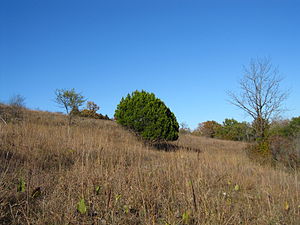Juniperus ashei
| Juniperus ashei | ||||||||||||
|---|---|---|---|---|---|---|---|---|---|---|---|---|

Juniperus ashei |
||||||||||||
| Systematics | ||||||||||||
|
||||||||||||
| Scientific name | ||||||||||||
| Juniperus ashei | ||||||||||||
| J. Buchholz |
Juniperus ashei is a plant from the family of the cypress family (Cupressaceae). It is native to the southern United States and northern Mexico.
description
Juniperus ashei grows as an evergreen shrub or small tree that can reach heights of 6 to 15 meters and a diameter of up to 50 centimeters at chest height . The trunk usually branches 1 to 3 meters above the ground. The long branches go straight or ascending from the trunk and form an open to dense, irregular to rounded crown . The stiff branches are not pendulous and have a square cross-section. The brown bark of the trunk and that of thick branches turn gray over time and flake off in thin strips. Usually it is colonized by a gray-white fungus. Thin branches have a pink bark that turns gray over time and begins to peel off.
The scale-like, green colored needles are diamond-shaped with a length of 1 to 2 millimeters and a width of 0.8 to 1.2 millimeters. They are often keeled and have a pointed tip and finely serrated needle edges. At the base of the underside of the needle there are several ostomy openings while there are two stomatal ligaments on the top of the needle. The glands on the needles are only indistinctly visible.
Juniperus ashei is dioecious-segregated ( diocesan ) and the seeds ripen in the first year. The numerous male cones stand individually on the branches and are spherical to egg-shaped with a length of 2 to 4 millimeters and a thickness of around 2 millimeters. They are initially yellowish-green and turn pink or light brown towards the flowering period. The berry-shaped cones are spherical to broadly egg-shaped with a thickness of 6 to 10 millimeters. They are initially pink-blue-green in color and turn dark blue as they mature. Each of the fleshy and resinous cones bears one to three shiny yellow-brown to maroon seeds. These are egg-shaped with a length of 4 to 6 millimeters and a width of 3 to 4.5 millimeters. The seedlings have two seed leaves ( cotyledons ).
The number of chromosomes is 2n = 22.
Distribution and location
The natural range of Juniperus ashei is in Mexico and the USA. In Mexico, they are only found in the state of Coahuila . In the USA they are found in Arkansas , in the Ozark Mountains of Missouri , in Oklahoma and on the Edwards Plateau in Texas .
Juniperus ashei thrives at altitudes of 150 to 1550 meters. It is a type of continental climate with warm summers and cold winters. The species is mainly found in clearings and along rivers, where it colonizes limestone soils. It mostly forms pure stands, but mixed stands with Juniperus pinchotii , various oaks ( Quercus ) and Pinus remota also occur .
use
The hard and durable but light wood of the species has a loose grain and is easy to work with. It gives off a slight odor. It is used locally as firewood, as well as to make fence posts, telephone poles, and railroad ties. In Texas, cedar oil is extracted from the wood using steam distillation . The ripe cones are edible both raw and cooked.
Systematics
It was first described as Juniperus ashei in 1930 by John Theodore Buchholz in Botanical Gazette 90, p. 329 . Synonyms for Juniperus ashei J. Buchholz are Juniperus mexicana Spreng. , Juniperus sabinoides (Kunth) Nees and Sabina sabinoides Small .
The species is divided into up to two varieties :
- Juniperus ashei var. Ashei is the nominate form. It occurs in Arkansas, Missouri, Oklahoma and Texas.
- Juniperus ashei var. Ovata R.P. Adams occurs in Coahuila and in Texas west of 101.2 ° W. The cones of this variety are around 6 millimeters in size and usually carry two seeds.
Hazard and protection
Juniperus ashei is listed as “not endangered” on the IUCN Red List . It is pointed out, however, that a new check of the risk is necessary.
swell
- Christopher J. Earle: Juniperus ashei. In: The Gymnosperm Database. www.conifers.org, December 12, 2010, accessed February 8, 2012 .
- Frank D. Watson, James E. Eckenwalder: Cupressaceae . Juniperus . In: Flora of North America Editorial Committee (Ed.): Flora of North America North of Mexico . Pteridophytes and Gymnosperms. Volume 2. Oxford University Press, New York a. a. 1993, ISBN 0-19-508242-7 , Juniperus ashei (English, Juniperus ashei - online - this work is online with the same text).
Individual evidence
- ↑ a b c d e f g h Christopher J. Earle: Juniperus ashei. In: The Gymnosperm Database. www.conifers.org, December 12, 2010, accessed February 8, 2012 .
- ↑ Juniperus ashei. In: Plants For A Future. www.pfaf.org, accessed February 8, 2012 (English).
- ↑ a b Juniperus ashei at Tropicos.org. Missouri Botanical Garden, St. Louis, accessed February 8, 2012.
- ↑ Rafaël Govaerts (ed.): Juniperus. In: World Checklist of Selected Plant Families (WCSP) - The Board of Trustees of the Royal Botanic Gardens, Kew . Retrieved March 26, 2019.
- ↑ Juniperus ashei in the endangered Red List species the IUCN 2011. Posted by: Conifer Specialist Group, 1998. Retrieved on February 8, 2012 Design.

